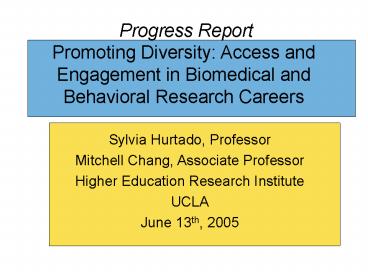Progress Report Promoting Diversity: Access and Engagement in Biomedical and Behavioral Research Careers - PowerPoint PPT Presentation
Title:
Progress Report Promoting Diversity: Access and Engagement in Biomedical and Behavioral Research Careers
Description:
Progress Report Promoting Diversity: Access and Engagement in Biomedical and Behavioral Research Careers Sylvia Hurtado, Professor Mitchell Chang, Associate Professor – PowerPoint PPT presentation
Number of Views:220
Avg rating:3.0/5.0
Title: Progress Report Promoting Diversity: Access and Engagement in Biomedical and Behavioral Research Careers
1
Progress Report Promoting Diversity Access
and Engagement in Biomedical and Behavioral
Research Careers
- Sylvia Hurtado, Professor
- Mitchell Chang, Associate Professor
- Higher Education Research Institute
- UCLA
- June 13th, 2005
2
Targeted Institutions and Participants
- Minority serving institutions (MSIs)
- Institutions that produce large numbers of
minority baccalaureates in the sciences (Top 50) - MARC/MBRS/MORE/PREP program institutionsincludes
PWIs and MSIs - Other types of selective institutions (liberal
arts colleges, private universities) - URMs, White and Asian students with intentions to
major in about a dozen biomedical/behavioral
science fieldssmall sample of URMs in other
fields
3
Research Plan Key Components
- CIRP Freshman Survey, administered at orientation
at over 720 institutions (baseline sample), 644
with URMs with initial intentions for
biological/behavioral science majors - YFCY End of First Year Survey, about 223
institutions agreed to participate, 104 NIH
targeted - Classroom-based studies of introductory courses
in MSIs and PWIs, and focus groups - CSS 4th Year of College Survey, approximately
- 10,000 students
4
Project Phase 1 CIRP Freshman Survey (SIF)
- 720 institutions with 424,000 freshmen
respondents - 51 MSIs (HBCUs HSIs)
- 64 institutions with NIH-sponsored programs
- Data collection completed Fall 2004
- Merging of institutional characteristics data
from IPEDS and possibly College Board academic
data and registrar data by the end of summer
\
5
Dissemination for Phase I
- One paper has been submitted for publication to
Research In Higher Education and presented at a
national conference May30 th - Analyses have begun on two additional papers to
be presented at national conferences, one report
to be released at the end of summer - Institutional reports Approx. 104 institutions
will receive reports and/or data on students in
NIH selected fields at the end of summer - All reports and papers are available for download
from the HERI/NIH website www.gseis.ucla.edu/heri/
nih
6
Phase I Research Questions
- What are the pre-college experiences and
characteristics (at college entry) of URM
students who show aspirations for scientific
research? - Are there institutional implications for
improving long-term retention and success in the
health-related scientific research fields that
build upon students' entering dispositions?
7
Pre-College Research Participation by Race
(weighted)
8
Pre-College Aspirations by Race (weighted)
9
Results Mean differences for Making a
Contribution to Scientific Research
10
Results Predictors of Intention to Make a
Contribution to Scientific Research
11
Results Predictors of Intention to Make a
Contribution to Scientific Research
12
Discussion of findings
- High aspirations of underrepresented minority
students - Importance of formal coursework and experiential
learning in the sciences while in high school - Self-efficacy and goal development supercedes
effect of academic credentials and background
characteristics - Connection between concern about finances and
intention to contribute to scientific research
13
Phase II First-year follow-up (YFCY)
- Focus on college experiences, access to
resources, survey instrument completed - We contacted 129 institutions based on
- status as an MSI
- presence of NIH-sponsored programs targeting URM
students - Number of URMs that responded to the SIF
- Number of URMs that indicated their college major
was in the biomedical or behavioral science fields
14
Phase II First-year follow-up (YFCY)
- 104 of targeted institutions agreed to
participate, 119 additional institutions
participated - Spring 2005 survey packets were mailed directly
to students - Paper/web survey option
- Email reminders were sent
- Phone calls to target groups
- Analyses will take place over 2005-06 with a
report available in 2006, institutions receive
their reports in Fall 2005
15
Resources
- Project website http//www.gseis.ucla.edu/heri/ni
h - Papers and reports available for download from
website - The American Freshman National Norms for Fall
2004 (order forms on HERI website)































